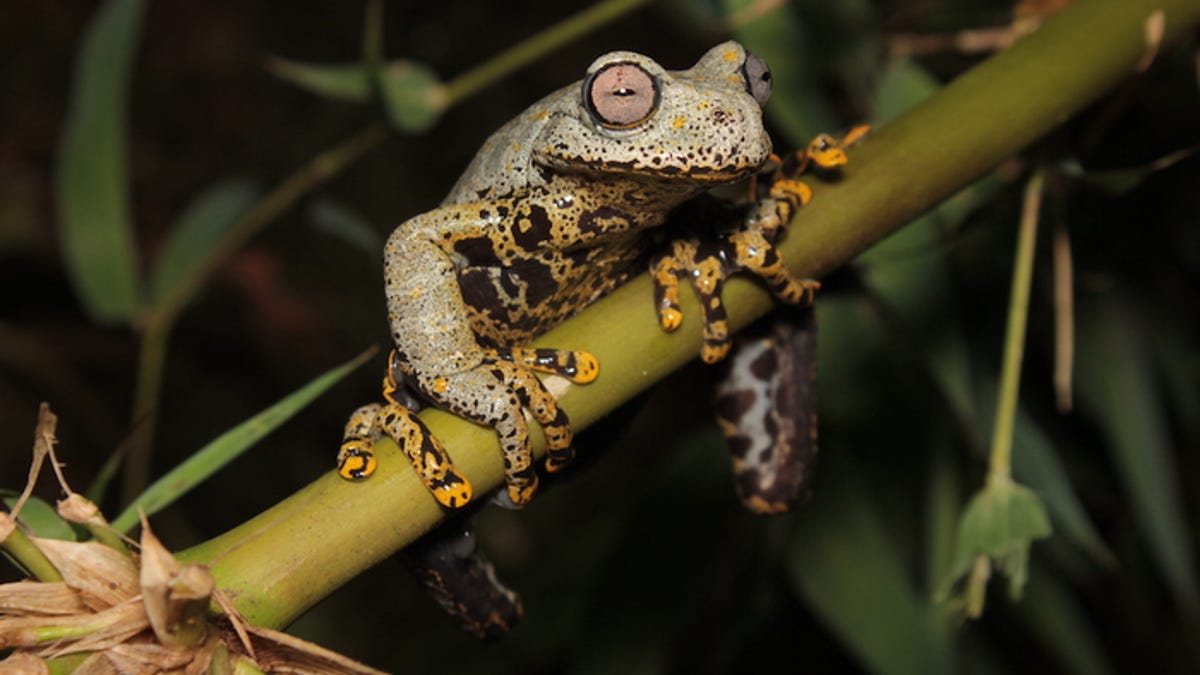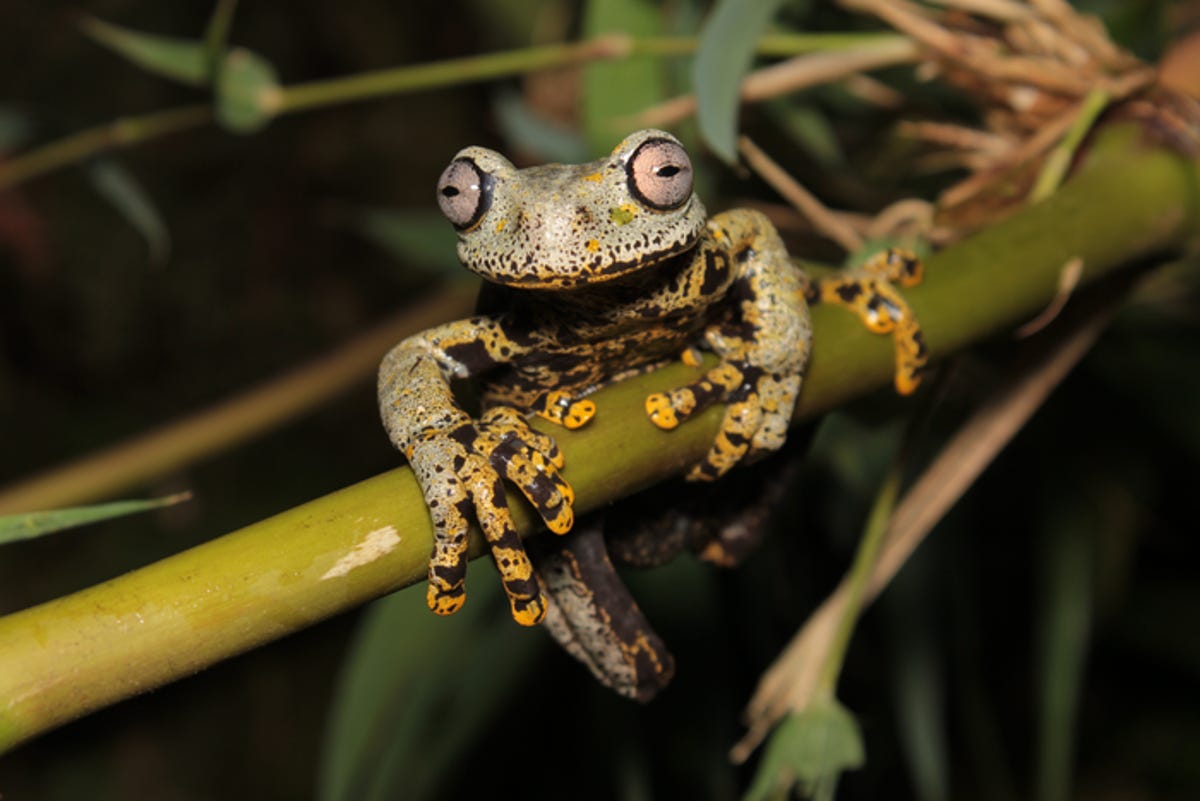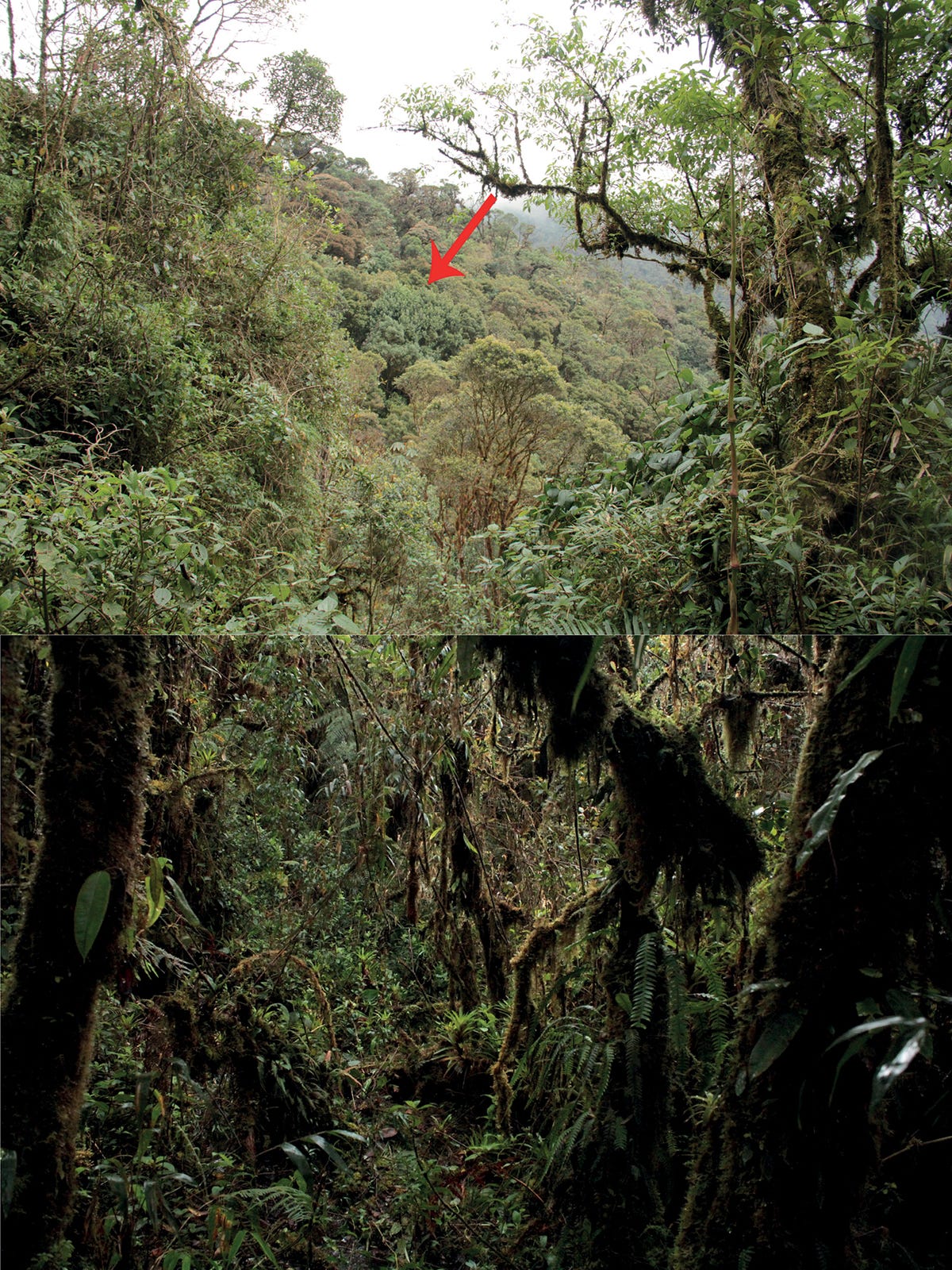
Hyloscirtus tolkieni hanging out in the forest.
Juan Carlos Sánchez-Nivicela / Archive Museo de Zoología, Universidad San Francisco de Quito
Deep inside Ecuador’s Río Negro-Sopladora National Park, the line between fantasy and reality vanishes. At least, that’s what scientists who recently discovered a new frog species say of their time exploring this multithousand-acre milieu of mountainous slopes, wispy trees, sparkling rivers and weeping ombré flowers.
They even named the golden-toed frog they stumbled upon Hyloscirtus tolkieni — after one of their favorite authors, J.R.R. Tolkien, writer of the Lord of the Rings series and the brains behind every whimsical crevice of Middle-earth.
“The new species of frog has amazing colors, and it would seem that it lives in a universe of fantasies, like those created by Tolkien,” Diego F. Cisneros-Heredia said in a statement. “The truth is that the tropical Andes are magical ecosystems where some of the most wonderful species of flora, funga, and fauna in the world are present.”
Cisneros-Heredia, an associate researcher at the National Institute of Biodiversity, is also co-author of a study on the find, published last month in the journal ZooKeys.
Funnily enough, in 2003, scientists spotted a brown, dotted frog that they named Breviceps bagginsi. Second half of that name sound familiar? Yup, this critter was named after Bilbo Baggins, a kind-mannered and very honorable hobbit from Tolkien’s beloved trilogy. Informally, B. bagginsi is also called “Bilbo’s Rain Frog.”
I can seriously imagine it sitting on Bilbo’s shoulder, a cute and slimy little pet to keep him company as he wanders the land.


Hyloscirtus tolkieni
Juan Carlos Sánchez-Nivicela / Archive Museo de Zoología, Universidad San Francisco de Quito
“Not all those who wander are lost”
At about 66 millimeters (2.5 inches) long, H. tolkieni is tiny enough to fit in the palm of your hand. But even with such a minuscule stature, it is stunning.
This novel species sports a grayish-green back contrasted with golden and black speckled hands and feet that look like those sticky slap hands you might have gotten at Chuck-E-Cheese in 2005. Its eyes feature a pale pink and black iris, and its throat, belly and side coat are yellowish with dark spots to match its long, flexible fingers and toes. When I hear people theorize about what aliens might look like, my mind wanders to precisely this sort of Earthling animal.
I can’t help but think: Gawking over three-eyed, big-headed beings is definitely tempting, but we can also check out real pictures of otherworldly creatures that share our corner of the cosmos. I mean, this one really resembles the kind of fictionalized species you’d find on a random planet in the sci-fi video game No Man’s Sky.
“For weeks, we explored different areas of the Río Negro-Sopladora National Park, walking from paramo grasslands at 3,100 meters elevation to forests at 1,000 [meters],” study co-author Juan Carlos Sánchez Nivicela, an associate researcher at the National Institute of Biodiversity, said in a statement. “We found a single individual of this new species of frog, which we found impressive due to its coloration and large size.”


The habitat of Hyloscirtus tolkieni. General landscape (above, red arrow pointing to collection site); and at the collection site inside the forest (below).
Juan C. Sánchez-Nivicela
Importantly, beyond being a visual marvel, this discovery adds to a massive ledger of species we know live in this enormous park — a haven for animals that was formally established in 2018 to serve as a link in a 100-mile chain of ecosystems in the Andes Mountains.
“Unfortunately, few areas are well-protected from the negative impacts caused by humans,” Cisneros-Heredia said. “Deforestation, unsustainable agricultural expansion, mining, invasive species and climate changes are seriously affecting Andean biodiversity.”
In fact, a significant number of endangered and generally threatened species live in the Río Negro-Sopladora National Park – such as the spectacled bear, Andean tapir, Andean condor and, per a press release about the team’s new study, 57% of amphibian species.
This park is also quite special, according to the conservation organization Nature and Culture International, because it offers what’s called a critical “escape valve” for species grappling with the harsh effects of climate change, as Cisneros-Heredia touches on. Basically, because this area holds a few mountaintops at very high altitudes, animals whose lower-altitude homes are no longer suitable, thanks to rising temperatures, can migrate upward to reach places with cooler temperatures.


Our World In Data
As for this new frog fit for the Shire, more research is required to understand its story, the team said. That’s because, so far, we only have located a single member of its clan.
“Large, forested areas remain unstudied in the national park, and the species may have a wider distribution beyond the immediate surrounding of its type locality,” the study authors write.
Nonetheless, the concept of this frog’s identification is crucial in a rapidly warming world.
If we’re to help conserve species dying out on a planet that’s warming due to human-induced climate change, we have to know who they are, where they come from and how many of them exist.
Otherwise, we’ll likely witness what’s known as “dark extinction” — the mass death of animals we never knew lived. Animals that roam our planet without a trace because we’ve never crossed paths with them, but secretly hold their own chapters in the encyclopedia of Earth. It’s like Tolkien himself once said: “Not all those who wander are lost.”
